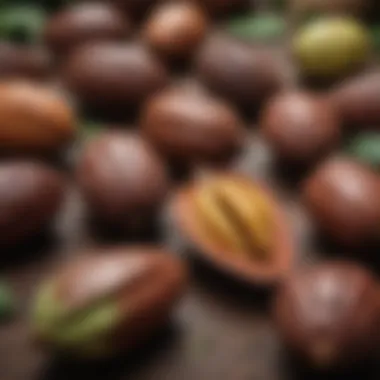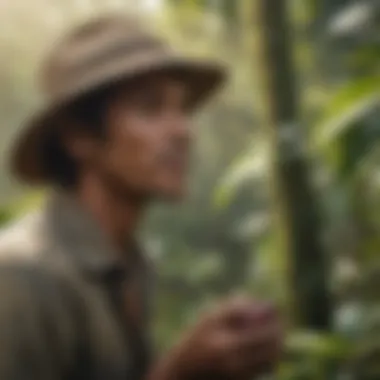A Comprehensive Guide to Buying Cacao Trees


Intro
Cacao trees are becoming increasingly popular among agriculture farmers and enthusiasts. These trees not only yield delicious cacao pods but also require thoughtful cultivation and care. With the rise of interest in cacao farming, there is a need to understand the key elements involved in acquiring and maintaining cacao trees effectively. This article provides guidance on the cultivation processes, the importance of sustainability, and market insights relevant to cacao tree sales.
As the demand for cacao increases, knowing how to source these trees responsibly becomes essential. The journey of cacao farming requires dedication and knowledge, making the following sections vital for anyone interested in stepping into this agricultural venture.
Latest Trends in Agriculture
Overview of Current Trends
The cacao industry is witnessing significant shifts due to changing consumer preferences and market demands. Organic and single-origin cacao products are gaining traction as buyers become more conscious about food quality and sourcing. This trend is influencing cacao farmers to adopt more sustainable practices and focus on quality rather than quantity.
Impact of Technology on Farming Practices
Technological advancements are reshaping the cacao cultivation landscape. Farmers are increasingly utilizing precision agriculture tools and apps that monitor soil health and moisture levels. These innovations can lead to better yields and more efficient growing practices. Additionally, drones and sensors are being used to assess crop health, enabling farmers to respond to issues promptly.
Implementing these tools requires investment, but the long-term benefits can be considerable. Effective technology use not only increases productivity but also enhances sustainability efforts.
Sustainable Practices: Towards a Greener Future
Importance of Sustainability in Agriculture
Sustainability is crucial in cacao farming. It ensures that agricultural practices do not harm the environment or deplete natural resources. Sustainable practices can lead to improved soil health, better water retention, and overall ecosystem balance. As consumers favor ethically sourced products, adopting sustainable methods can also enhance marketability.
Methods for Sustainable Farming
Farmers interested in sustainable cacao cultivation can consider the following methods:
- Agroforestry: Incorporating cacao trees with other crops or trees to create a diverse ecosystem.
- Organic Farming: Utilizing natural fertilizers and pest control methods to reduce chemical exposure.
- Water Management: Implementing drip irrigation systems to conserve water and maintain soil moisture.
By adopting these practices, farmers not only contribute to environmental health but also create a more resilient farm.
Gardening Techniques and Tips
Essential Gardening Tools and Equipment
To start a successful cacao farm, having the right tools is essential. Some commonly used tools include shovels, pruners, fertilizer spreaders, and mulch. Each tool plays a vital role in ensuring the health and productivity of cacao trees.
Seasonal Gardening Practices
Understanding seasonal changes is important for cacao cultivation. Here are some practices to consider through the year:
- Planting: The best times to plant cacao seeds are during the wet season.
- Pruning: Regular pruning during dry periods can improve air circulation and promote healthy growth.
- Harvesting: Cacao pods are typically ready for harvest around five to six months after flowering.
"Sustainable practices in cacao farming not only promote environmental responsibility but also cater to the growing consumer demand for ethically sourced products."
Prolusion to Cacao Trees
Cacao trees, the source of the highly coveted cocoa beans, play a vital role in both agriculture and the global economy. Understanding these trees is crucial for anyone interested in cultivation, whether for personal use or commercial farming. This section will touch on the significance of cacao trees, the specific elements to consider about their growth, and the benefits they provide.
Cacao trees thrive in tropical climates and require specific conditions to flourish. They serve as a sustainable crop choice for many farmers, enhancing biodiversity and contributing to local economies. Cacao cultivation can offer various advantages, such as income from bean sales and product diversification.
Understanding the Cacao Tree
The cacao tree, known scientifically as Theobroma cacao, typically grows to a height of 15 to 25 feet. Its unique foliage and small white flowers give rise to the cacao pods which hold the treasured cocoa beans. These pods change from green to vibrant orange or yellow as they ripen, making the cacao tree a visually interesting addition to any farm. This tree's growth cycle takes time, with flowering occurring throughout the year under suitable conditions. Mature trees can produce pods within three to five years post-planting.
Cacao trees prefer well-drained, loamy soils rich in organic matter. They thrive under a canopy of taller trees in shaded areas, which provides them protection from harsh sunlight. Managing their growth requires an understanding of local environmental factors, as well as proper cultivation techniques. For example, regular pruning can help maintain healthy tree structure and increase yields thoroughly.
Cultural and Economic Significance


Cacao has deep cultural roots in many regions, particularly in Central and South America. Historically, cacao was used not only as a food source but also as a currency. In modern economies, the cultural significance translates into economic opportunities.
The global demand for chocolate drives cacao production. Countries such as Ivory Coast, Ghana, and Indonesia are leading producers, but small-scale farmers also contribute significantly. Investing in cacao trees offers prospects for sustainable development, as the industry pushes towards responsible practices. This includes fair trade initiatives which benefit local farmers and promote ethical sourcing.
Key benefits of cultivating cacao include:
- Income Generation: Cacao farming creates economic opportunities for many communities.
- Biodiversity: Cacao farms can maintain native plant species and provide habitats for wildlife.
- Sustainability: With proper farming methods, cacao cultivation can be environmentally friendly.
"Cultivating cacao trees not only enhances local economies but also enriches the culture and traditions of regions where they are grown."
Cacao Tree Varieties
Cacao trees are not all the same. Understanding the different cacao tree varieties is essential for anyone interested in cultivating or purchasing these trees. Each variety brings unique characteristics, flavor profiles, and growth requirements. This knowledge allows buyers to make informed decisions based on their specific needs and environmental conditions. The right choice can enhance both yield and quality, making it a significant aspect of cacao cultivation.
Criollo
Criollo is often regarded as the finest cacao variety. Renowned for its rich flavor and aroma, it is considered the heirloom of cacao types. Criollo trees are sensitive and require specific growing conditions, such as well-drained, nutrient-rich soil. They thrive in humid tropical climates, and while they may offer remarkable beans, they are susceptible to diseases and pests. Cultivators should weigh the pros and cons carefully before choosing Criollo, as it demands more attention and care.
Forastero
Forastero is the most widely grown cacao variety. It is more resilient and robust than Criollo, making it an appealing option for many farmers. This variety is known for its strong and bitter chocolate flavor, which is often used in mass-produced chocolates. Forastero trees can grow in a variety of conditions, but they flourish in well-draining soil and warmer climates. They are also more resistant to common diseases, allowing for a higher yield. This makes Forastero an ideal choice for commercial purposes, where volume is often essential.
Trinitario
Trinitario is a hybrid of Criollo and Forastero. This variety seeks to capture the best attributes of both parent types. Trinitario has a unique flavor profile that balances the complex notes of Criollo with the hardiness of Forastero. This makes it a popular choice among craftsmen chocolatiers. Trinitario trees require moderate care and can withstand some adverse conditions. However, like Criollo, they benefit from rich, moist soils. By opting for Trinitario, cultivators can enjoy both quality and quantity, appealing to both niche markets and larger chocolate producers.
Cacao Tree Growth Requirements
Understanding the growth requirements of cacao trees is fundamental for anyone looking to cultivate these valuable plants. The cacao tree, Theobroma cacao, thrives in specific conditions that significantly impact its health, yield, and overall productivity. As the demand for high-quality cacao increases, addressing these growth requirements has become even more crucial for both commercial growers and hobbyists. Properly meeting these needs not only ensures the longevity of the trees but also maximizes the potential output of cacao beans, which are essential for chocolate production.
Soil Requirements
Soil plays a pivotal role in the growth of cacao trees. They prefer deep, well-draining soils rich in organic matter. A pH level between 6 and 7 is ideal for optimal nutrient absorption. It's important to avoid compacted soils, as they can lead to poor root development.
Some key considerations regarding soil include:
- Nutrient Content: Rich soil contributes to tree vitality. Regular soil tests can help in determining nutrient needs and deficiencies.
- Organic Matter: Incorporating compost or decomposed matter boosts soil fertility. This practice enhances the growth of beneficial microorganisms.
- Drainage: Cacao trees are sensitive to waterlogged conditions. Good drainage prevents root rot and other diseases. Silty loam soils are often the best for cacao cultivation.
Climate Considerations
Cacao trees are inherently tropical plants that require a warm, humid environment to flourish. They are typically grown in regions near the equator, where temperatures average between 20 to 30 degrees Celsius. When planning to cultivate cacao, it’s essential to consider climate factors such as:
- Temperature: Extreme cold can damage cacao trees. Areas susceptible to frost should be avoided.
- Humidity: A humidity level of at least 70% is recommended to prevent stress to the tree.
- Sunlight: While cacao trees can tolerate some shade, they grow best under partial sunlight, with 30 to 50% shade being ideal.
Watering and Drainage Needs
Water management is crucial for cacao tree health. Consistent watering practices must be established, ensuring the trees receive adequate moisture without becoming waterlogged.
To achieve optimal watering and drainage:
- Irrigation: Regular watering is necessary, especially during dry seasons. Drip irrigation systems can efficiently deliver water to the trees.
- Mulching: Applying mulch helps retain soil moisture, regulate temperature, and suppress weeds.
- Water Quality: Use clean water free of pollutants, as poor-quality water can affect the tree's growth.
- Drainage Systems: Implementing effective drainage practices prevents water buildup, which can lead to root diseases. Planting cacao on slightly elevated areas can help manage excess water.
"Understanding the growth requirements is the first step towards successful cacao cultivation."
Proper attention to these elements—soil, climate, and water—is essential. By establishing suitable conditions, growers can enhance the growth potential of cacao trees and ensure healthier, more productive plants.
Purchasing Cacao Trees
Purchasing quality cacao trees is key for anyone interested in cultivating cacao, whether for personal use or commercial production. Selecting the right trees impacts overall growth, yield, and quality of the cacao produced. Understanding purchasing options allows growers to make educated decisions. This section considers different sources for acquiring cacao trees, offers guidelines on evaluating quality, and addresses pricing factors that influence the purchase.


Where to Buy Cacao Trees
Finding suitable cacao trees requires examining several sources, each with unique advantages and limitations.
Local Nurseries
Local nurseries are often the most accessible source for purchasing cacao trees. These nurseries typically provide region-specific varieties suited for local soil and climate conditions. One key characteristic of local nurseries is their ability to offer personalized advice and support to growers. This interaction can be invaluable for first-time buyers or those unfamiliar with cacao cultivation.
A major advantage of local nurseries is the possibility of inspecting the trees in person before making a purchase, ensuring that buyers can observe the health and condition of the plants. However, local nurseries may have limited stock and fewer rare varieties compared to broader retail options. Additionally, prices can be higher due to overhead costs associated with maintaining a physical store.
Online Retailers
Online retailers present a convenient option for finding cacao trees, especially for those who live in areas without local nurseries. A characteristic of online retailers is the extensive variety of trees available, allowing growers to find specific strains and genetic lines. Buyers can quickly compare offerings from multiple retailers, which can lead to better deals.
One unique feature of online shopping is the ease of access to reviews and ratings from other customers. This feedback can help in assessing the reliability of suppliers. Nonetheless, purchasing online carries risks, including the inability to assess tree quality firsthand. Shipping conditions can also affect the trees' health, making careful selection of the retailer essential.
Agricultural Expos
Agricultural expos offer a dynamic environment for purchasing cacao trees, providing an opportunity to interact directly with growers and breeders. These events often showcase new varieties and farming technologies, making them an excellent platform for growers to learn about best practices in cacao cultivation. Expos can feature multiple vendors, allowing for comparison and competition, which can potentially drive down prices.
One significant advantage of expos is the chance to attend workshops and seminars that deepen knowledge of cacao cultivation. On the downside, access to expos may be limited geographically and they occur only at certain times of the year. This may require interested buyers to plan accordingly to take advantage of these events.
Evaluating Tree Quality
Quality is crucial when purchasing cacao trees, as unhealthy trees can lead to poor yield or even tree failure. Buyers should look for vibrant leaves with no signs of yellowing or wilting. The stem should be sturdy, and the overall shape should be balanced without deformities. Additionally, it is useful to check for the presence of pests or signs of disease. Many sellers offer guarantees, which can be a good sign of confidence in the trees' quality.
Pricing Factors
The cost of cacao trees can vary widely, influenced by several factors. Varieties can dictate price differences. Rare or heritage types often carry higher prices. Other factors include the age of the tree and its size, with mature trees typically selling for more. Location of purchase matters too; local nursery prices might reflect the cost of local growing conditions and labor, while online prices may include shipping costs. More than just sticker price matters, though—consider overall value in terms of tree quality, vigor, and support from the seller.
In summary, purchasing cacao trees involves understanding various sources, evaluating tree quality, and being aware of pricing factors to make informed decisions.
Cacao Tree Cultivation Techniques
Cacao tree cultivation is a critical aspect for anyone looking to start their journey in cacao farming. Understanding the various cultivation techniques not only ensures the health of the trees but also significantly impacts the quality and yield of beans produced. Proper cultivation practices can lead to a sustainable and profitable venture. This section will elaborate on important cultivation techniques, including planting procedures, fertilization methods, and effective pest and disease management strategies.
Planting Procedures
The success of cacao cultivation begins with the planting process. It is vital to select the right location and prepare the soil accordingly. Here are essential steps to follow during planting:
- Site Selection: Choose a location with partial shade and good drainage. It is ideal if the site is near other trees that can provide some cover from direct sunlight.
- Seed Preparation: Select high-quality seeds or seedlings from reputable sources. Ensure to check for health and consistency in development.
- Spacing: When planting cacao trees, ensure adequate spacing between each tree. This allows for proper airflow and sunlight, preventing fungal infections.
- Planting Depth: Dig holes that are about double the size of the root ball. Position the seedling so that the root collar is level with the soil surface. Fill the hole with soil and water thoroughly.
These steps can greatly enhance the chances of the cacao trees establishing a strong root system, leading to healthy growth.
Fertilization Techniques
For cacao trees to thrive, proper fertilization is crucial. Knowing when and how to fertilize can enhance soil fertility and promote growth. Here are some guidelines:
- Organic Fertilizers: Using organic options like compost or manure can improve soil structure and fertility while being environmentally friendly. These fertilizers release nutrients gradually.
- Chemical Fertilizers: While organic is preferable, some situations may call for chemical fertilizers. Such products should be applied in moderation to avoid nutrient burn.
- Nutrient Analysis: Conduct soil tests to identify nutrient deficiencies. This will help in applying specific fertilizers to meet the needs of the trees.
- Fertilization Timing: Apply fertilizers during the rainy season or just before the start of the wet season. This facilitates better nutrient absorption.
By employing effective fertilization techniques, a cacao farmer can ensure optimal growth and development of their trees, ultimately enhancing productivity.
Pest and Disease Management
Cacao trees, like any other plants, face threats from pests and diseases which can diminish their quality and yield. Effective management strategies are essential to mitigate these risks. Consider the following methods:
- Regular Monitoring: Regular inspection of the trees can help in early detection of any pests or diseases. Look for unusual signs such as wilting leaves or discoloration.
- Integrated Pest Management (IPM): Utilize a combination of biological control, habitat manipulation, and resistant varieties to manage pest populations. This reduces reliance on chemical pesticides.
- Sanitation Practices: Keeping the plantation clean from fallen fruits and dead plant matter can help prevent the spread of diseases.
- Chemical Treatments: As a last resort, use targeted and environmentally friendly pesticides if the infestation is severe. Always follow application guidelines to minimize harm to beneficial insects.
Implementing these pest and disease management practices ensures a healthier cacao crop and can safeguard future yields.


Sustainable Practices in Cacao Farming
Sustainable practices in cacao farming are vital for the long-term health of the ecosystem and the cacao industry. These practices aim to balance economic needs with environmental and social considerations. For farmers, adopting sustainability is not just a trend, but a necessity to maintain soil health, reduce pests, and ensure a viable livelihood.
Soil Conservation Techniques
Soil health is critical in cacao farming. Healthy soil produces better yield and quality of cacao beans. Soil conservation techniques help prevent erosion and nutrient depletion. Here are some effective methods:
- Cover cropping: This involves planting crops that can cover the soil, protecting it from erosion. Cover crops can improve soil quality and provide habitat for beneficial organisms.
- Terracing: Especially crucial on slopes, terracing slows down water runoff and helps to maintain moisture in the soil.
- Mulching: Applying organic materials on the soil surface can reduce evaporation, suppress weeds, and provide nutrients as they decompose.
Implementing these techniques leads to improved soil structure and fertility, benefiting cacao trees in the long run.
Integrated Pest Management
Pest control is a significant concern in cacao farming. Integrated Pest Management (IPM) offers a balanced approach to managing pests while minimizing chemical use. IPM combines different strategies:
- Cultural control: Modifying farming practices, such as crop rotation or selecting pest-resistant varieties, can help reduce pest populations.
- Biological control: This strategy uses natural predators or parasites to control pest populations. For instance, introducing certain insects can help manage pests in the cacao field.
- Chemical control: When necessary, using pesticides in a targeted manner is important. Farmers should choose environmentally friendly options and apply them only when pest levels exceed economic thresholds.
Implementing sustainable pest management strategies not only protects the cacao trees but also promotes biodiversity.
With sustainable practices, cacao farming becomes more resilient, ensuring that farmers can produce cacao in an environmentally friendly manner while maintaining profitability.
Market Trends for Cacao Trees
The cacao tree industry is influenced by multiple market trends that shape both the cultivation and purchase of these trees. Understanding these trends is crucial for anyone involved in cacao farming, whether as a commercial farmer or as an individual enthusiast. Market dynamics can direct decision-making related to planting, harvesting, and even investment in this sector.
One key element in market trends is the increasing global demand for high-quality chocolate. This demand influences the price and availability of cacao trees, as farmers strive to produce premium cacao varieties. Additionally, sustainability has become a focal point, impacting consumer preferences and, consequently, market trends. As awareness of environmental issues grows, there is a push for the cultivation of cacao trees in ways that do not harm the ecosystem. The market increasingly rewards those who adopt sustainable farming methods.
Benefits of Understanding Market Trends:
- Enables better decision-making in tree selection based on demand.
- Helps in optimizing growing practices according to market expectations.
- Improves the chances of success in commercial ventures through informed strategies.
Market Demand Analysis
Market demand for cacao trees has risen substantially in recent years. This trend can be attributed to the growing popularity of organic and artisanal chocolate products. Consumers are willing to pay a premium for cacao sourced from sustainable farms, further driving up demand. Data indicates that regions focusing on high-quality cacao production, such as Criollo and Trinitario varieties, have seen significant interest from buyers looking for specialty products.
In addition, the rise of vegan and health-conscious consumers has increased the market for cacao products beyond traditional chocolate. Superfoods made from cacao are gaining traction, and farms that understand this shift can adapt by offering diverse products, including cacao powder and nibs. If you are considering cacao cultivation, aligning with these demand trends will be vital.
Key Considerations for Farmers:
- Monitor market trends related to flavor preferences and health trends.
- Engage with local and international markets for better insights.
Export Opportunities and Challenges
Cacao farming offers numerous export opportunities, especially for regions known for their unique varieties and sustainable practices. Countries such as Ecuador, Ghana, and the Ivory Coast are some of the leading exporters of cacao beans on the global market. Increased demand for organic and ethically sourced cacao creates a pathway for small and medium-sized farms to enter the market, often through direct trade relationships.
However, challenges remain prevalent. Trade regulations can vary significantly between countries, and farmers must navigate tariffs, export licenses, and quality certifications to successfully export their products. Moreover, fluctuating prices can make it difficult to maintain profitability. Farmers need to stay informed about market conditions and adjust their practices accordingly.
The balance of supply and demand in the cacao market can dictate pricing strategies. It is crucial to be adaptive in your approach to planting and harvesting based on market shifts.
Challenges to Consider:
- Regulatory issues can complicate export processes.
- Price volatility may affect profit margins.
Understanding both the demand analysis and the export landscape allows cacao farmers to better prepare their strategies for market navigation.
Epilogue
The conclusion of this article emphasizes the vital aspects of cacao tree farming, a practice that holds significant promise for both individual and commercial growers. By understanding the complexities surrounding cacao cultivation, farmers can navigate the challenges that often arise in this field.
The Future of Cacao Farming
As we look ahead, the future of cacao farming presents both exciting possibilities and challenges. With the increasing global demand for chocolate, farmers must adapt to changing market conditions. Sustainability plays a crucial role in how cacao is grown, as consumers become more conscious of the environmental impact.
Furthermore, advancements in agricultural technology can improve yield and disease resistance, making cacao a more viable crop. Farmers are encouraged to explore innovative practices such as intercropping and organic farming. These methods not only enhance biodiversity but also improve soil health.
In summary, investing in knowledge about cacao trees and their cultivation will benefit farmers and contribute to a resilient agricultural sector. The interplay of market trends, sustainable practices, and technological advancements will shape the future landscape of cacao farming.







